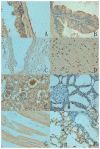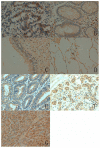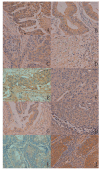Expression pattern and level of ING5 protein in normal and cancer tissues
- PMID: 30655738
- PMCID: PMC6313139
- DOI: 10.3892/ol.2018.9581
Expression pattern and level of ING5 protein in normal and cancer tissues
Abstract
Inhibitor of growth family 5 (ING5) functions as a type-II tumor suppressor gene and exerts an important role in DNA repair, apoptotic induction, proliferative inhibition, chromatin remodeling and the invasion process. In the present study, immunohistochemistry was performed to characterize the expression profile of ING5 protein on a tissue microarray containing mouse and human normal tissues, and human cancer tissues, including hepatocellular (n=62), renal clear cell (n=62), pancreatic (n=62), esophageal squamous cell (n=45), cervical squamous cell (n=31), breast (n=144), gastric (n=196), colorectal (n=96), endometrial (n=96) and lung carcinoma (n=192). In the mouse tissues, ING5 expression was detected in the cytoplasm of neurons, the nephric tubule and glomerulus, alveolar epithelium, gastrointestinal glands, squamous epithelium of the skin and skeletal muscles. By contrast, ING5 was localized to the cell nucleus in breast tissues. In human tissues, ING5 protein was primarily localized in the cytoplasm. However, ING5 was detected in the cytoplasm and nucleus in various types of normal tissues, including the tongue, stomach, intestine, lung and breast. In total, ING5 expression was detected in 400/986 cancer tissues (40.6%). In the majority of cases, ING5 expression was observed to be restricted to the cytoplasm. However, ING5 was also detected in the nucleus in a number of cancer tissues, including gastric, colorectal and lung carcinoma. Notably, ING5 was more frequently expressed in breast (79.9%), colorectal (56.3%) and endometrial carcinoma (50.0%). The incidence of ING5 expression in hepatocellular carcinoma (14.5%) and pancreatic carcinoma (22.6%) was low. These findings indicate that ING5 may be involved in cell regeneration and be associated with colorectal carcinogenesis.
Keywords: cancer; expression profile; human; immunohistochemistry; inhibitor of growth family 5; mouse.
Figures




Similar articles
-
The roles of ING5 in cancer: A tumor suppressor.Front Cell Dev Biol. 2022 Nov 8;10:1012179. doi: 10.3389/fcell.2022.1012179. eCollection 2022. Front Cell Dev Biol. 2022. PMID: 36425530 Free PMC article. Review.
-
Expression profiles of inhibitor of growth protein 2 in normal and cancer tissues: An immunohistochemical screening analysis.Mol Med Rep. 2016 Feb;13(2):1881-7. doi: 10.3892/mmr.2015.4723. Epub 2015 Dec 28. Mol Med Rep. 2016. PMID: 26717876
-
Immunohistochemical profile of ING3 protein in normal and cancerous tissues.Oncol Lett. 2017 Mar;13(3):1631-1636. doi: 10.3892/ol.2017.5632. Epub 2017 Jan 23. Oncol Lett. 2017. PMID: 28454301 Free PMC article.
-
mRNA and protein of p33ING1 in normal and cancer tissues.Transl Cancer Res. 2020 May;9(5):3623-3633. doi: 10.21037/tcr.2020.04.28. Transl Cancer Res. 2020. PMID: 35117725 Free PMC article.
-
Tumor metastasis-associated human MTA1 gene and its MTA1 protein product: role in epithelial cancer cell invasion, proliferation and nuclear regulation.Clin Exp Metastasis. 2003;20(1):19-24. doi: 10.1023/a:1022534217769. Clin Exp Metastasis. 2003. PMID: 12650603 Review.
Cited by
-
Hsa_circ_0010729 is Involved in Oxygen-Glucose Deprivation/Reoxygenation-Induced Human Microvascular Endothelial Cell Deprivation by Targeting miR-665/ING5.Biochem Genet. 2022 Dec;60(6):2455-2470. doi: 10.1007/s10528-022-10225-4. Epub 2022 Apr 28. Biochem Genet. 2022. PMID: 35482130
-
Upregulation of miR-376c-3p alleviates oxygen-glucose deprivation-induced cell injury by targeting ING5.Cell Mol Biol Lett. 2019 Dec 4;24:67. doi: 10.1186/s11658-019-0189-2. eCollection 2019. Cell Mol Biol Lett. 2019. PMID: 31844418 Free PMC article.
-
Molecular mechanisms of inhibitor of growth (ING) family members in health and malignancy.Cancer Cell Int. 2022 Sep 2;22(1):272. doi: 10.1186/s12935-022-02693-w. Cancer Cell Int. 2022. PMID: 36056353 Free PMC article. Review.
-
The roles of ING5 in cancer: A tumor suppressor.Front Cell Dev Biol. 2022 Nov 8;10:1012179. doi: 10.3389/fcell.2022.1012179. eCollection 2022. Front Cell Dev Biol. 2022. PMID: 36425530 Free PMC article. Review.
-
Scientific Research Directions on the Histopathology and Immunohistochemistry of the Cutaneous Squamous Cell Carcinoma: A Scientometric Study.Medicina (Kaunas). 2022 Oct 13;58(10):1449. doi: 10.3390/medicina58101449. Medicina (Kaunas). 2022. PMID: 36295609 Free PMC article.
References
LinkOut - more resources
Full Text Sources
